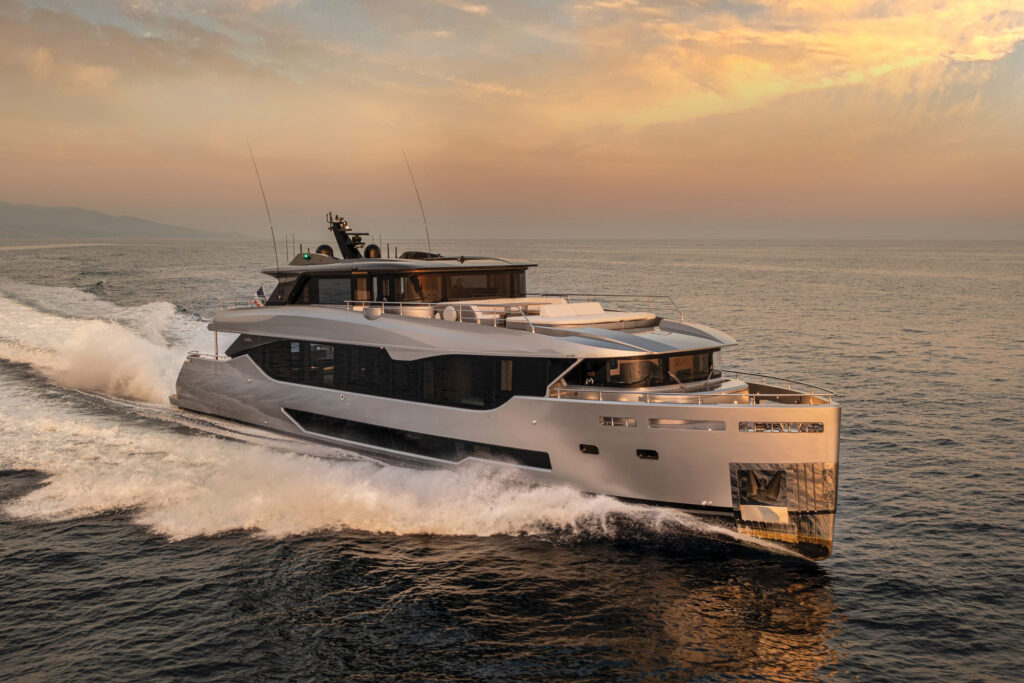
The first Maiora I ever reviewed was an 80-foot flybridge called Max & Ale, back in the mid-1990s. It had a dark, high-gloss, flame-cut mahogany interior with a lot of bright, canary-yellow upholstery. That yacht had a personality, plain and simple.
More recently, I got aboard Pesa II, which is a Maiora 35 Exuma, and I wondered what kind of personality a yacht with the model designation Exuma might have. Despite all my years of getting on boats, I have never visited the Bahamas—a massive omission for someone in my deck shoes, I know. But alas, it’s all too true, for now at least. My online search led me to the Bahamian musician Tony McKay, also known as Exuma, who is currently my go-to life soundtrack. Soon, I was reading up on the island chain that runs southeast of Nassau down to Great Exuma. Pals with years of experience cruising those shoal waters tell me the Exumas are some of the most idyllic islands in the world, especially if you like scuba diving. But you do need the right boat to get the most out of them, with a shoal draft and good speed.

Pesa II is just such a yacht. This 115-foot composite trideck launched last May with a striking, silver-metallic livery and an unusual general arrangement.
Approaching from the stern, guests step aboard at the swim platform. Curved “palazzo steps” extend across the transom. While the cockpit is conventional enough—it has a sun pad and booth-sofa island, as well as stairs to the deck above—what lies beyond is far from ordinary. You could say this yacht is almost a wide-body, or even that it has partial asymmetry. At the main-deck level, it has a sizable salon with a single, well-protected side deck to port and a full-beam owners’ stateroom forward, plus a few other surprises.
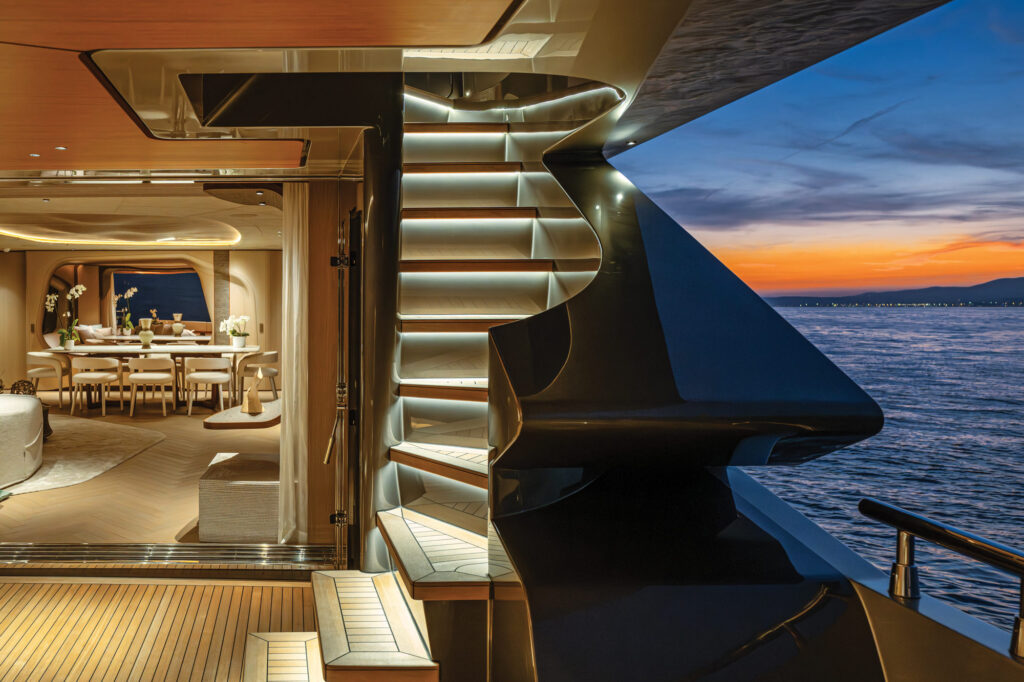
The salon aboard Pesa II has three zones. An L-shaped sofa is to port, with a dining table for eight to 10 guests forward, and a pair of armchairs and a coffee table to starboard. The views through picture windows make the whole space feel special.
Above, the upper deck is accessed via stairs that arch between an amidships lobby to starboard, and a pantry and the main galley to port. The upper deck is a supremely flexible entertainment space. It has outdoor sun loungers and an inside sky lounge, which, on Pesa II, has a sofa to starboard and formal dining forward to port. There’s also a three-monitor bridge console with a centerline pilot seat flanked by double bench seats, all upholstered in a diamond-stitched cream leather.
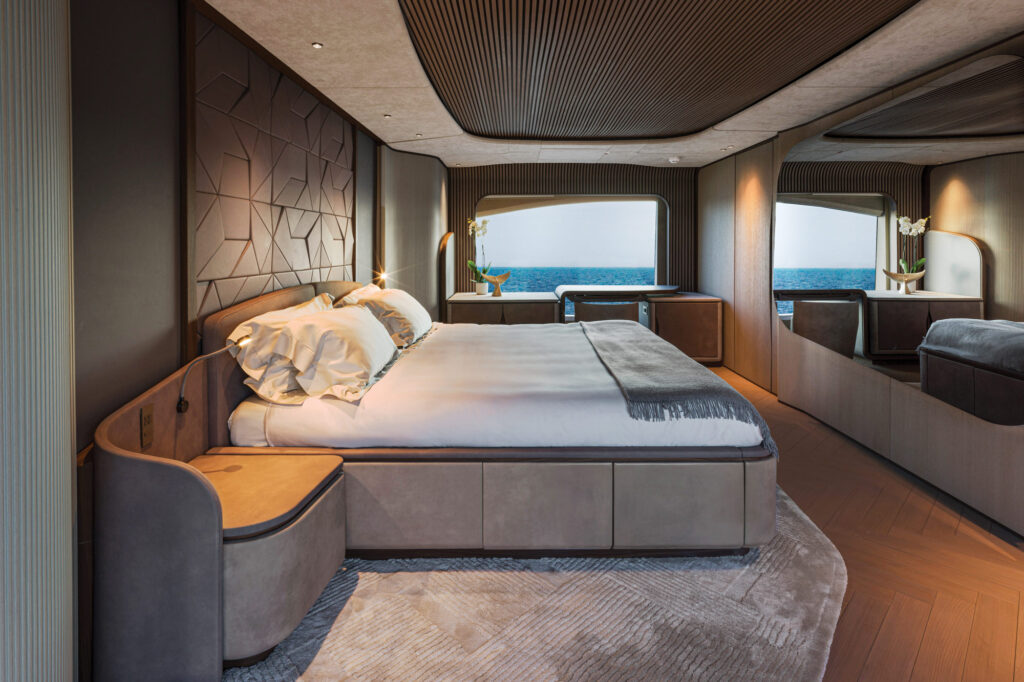
Side doors access wing stations and, ultimately, the foredeck terrace. Beyond those side doors, the whole deck space can be opened up to the elements via a sliding sunroof, drop-down side glazing and the aft-deck doors. The Maiora team calls the space a “fly on demand” because it almost becomes one enormous flybridge.
This design is most unusual for also providing a smaller wheelhouse forward on the main deck. It has doors on each side that access the working foredeck, and a dogleg staircase to port that connects with the crew area belowdecks. The crew space has a galley and mess to port, a captain’s double-berth cabin to starboard, and two twin-bunk cabins on each side of the fo’c’sle.
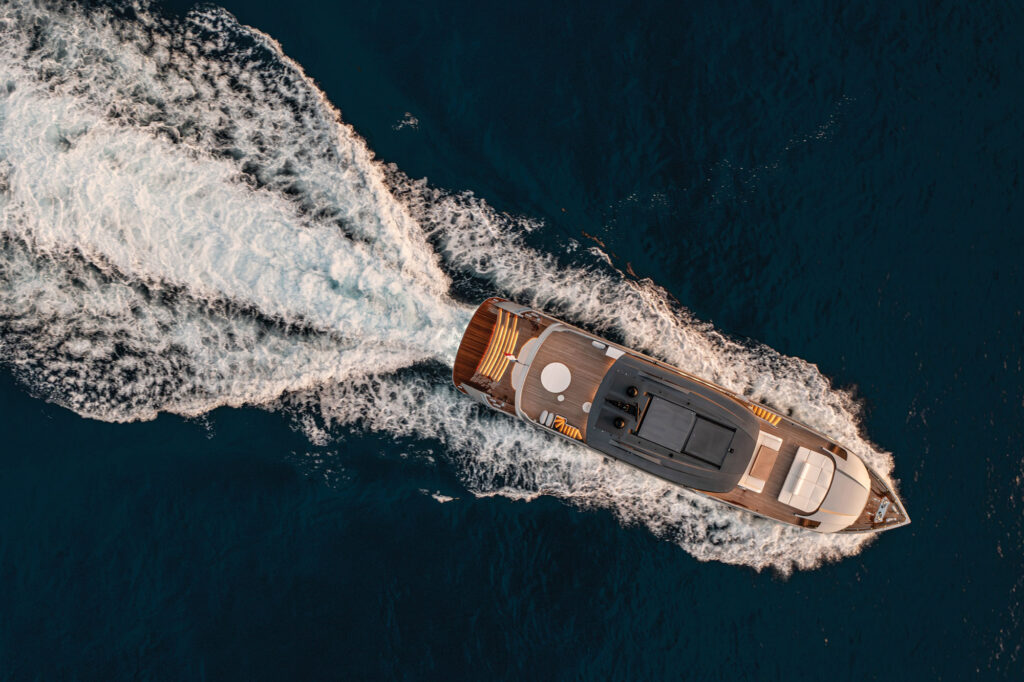
The owners’ stateroom has a forward-facing super-king berth with a vanity/desk to port and a corner sofa to starboard. Its en suite and walk-in closet are forward. Pesa II’s guest accommodations are belowdecks: four double-berth staterooms accessed from an amidships lobby. The aft stateroom’s double berths convert to twins, and one of the staterooms aboard Pesa II has a Pullman berth. The other two guest staterooms are amidships, one of them a larger VIP. Both have double berths, and the VIP’s berth is positioned for great views of the outdoors.
There’s an organic feel to Pesa II’s interior, which Maiora’s creative team worked up with the yacht’s owners. A big-block parquet sole with matte oaks and bleached-walnut veneer detailing sets the tone. The sky lounge has a teak sole. The color palette throughout the yacht features whites, creams, fawns and taupes, as well as bright marbles for tables and bathrooms. It’s a soft, contemporary vibe that, to my eye, has a hint of the late 1960s and early 1970s in the low-furniture choices. Virtually everything is curved, ribbed, rounded or radiused. All of the mirrors are irregular shapes, and they bounce around the natural light that comes through the glazing.
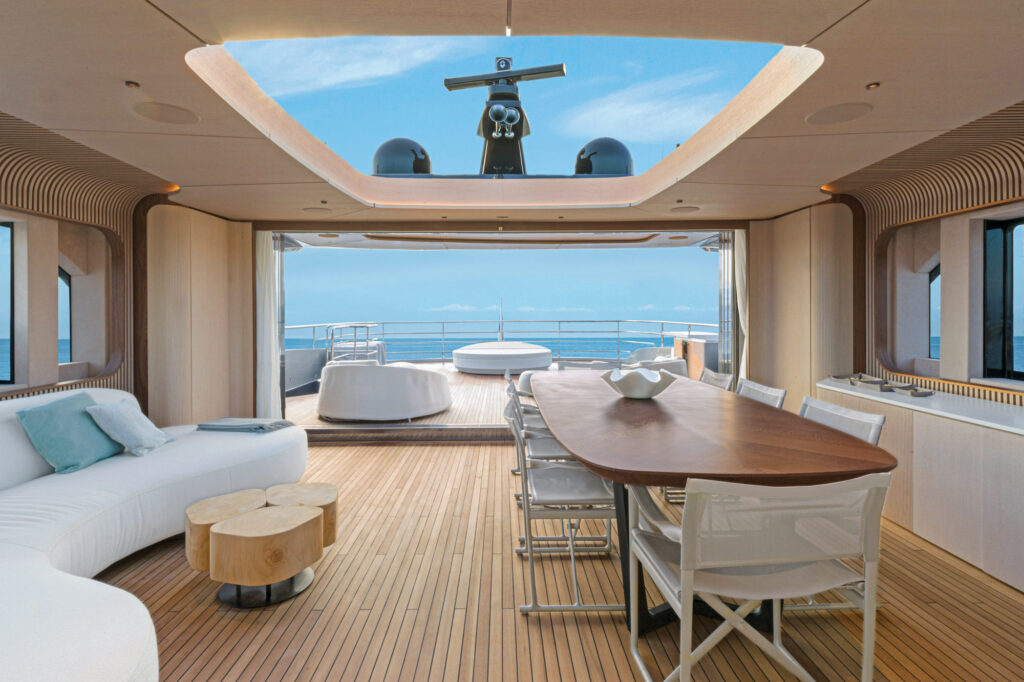
And then, there’s performance. Despite the yacht’s near-plumb bow, which maximizes the waterline length at displacement speeds, everything below the waterline is aimed at planing performance. There’s a V-hull form with spray rails and chine flats. Power is triple 2,000 hp MTU 12V 2000 M96X diesels paired to triple MJP water jets. The two outer jets are steerable, and the center one serves as a booster.
Maiora’s quoted top speed is normally 35 knots, but Pesa II’s top-end is a couple of knots slower. This yacht is available for charter, and it has “night mode” lithium-ion batteries that supply hotel loads without running the engines—a great feature, but one that adds significant battery weight. Thus, Pesa II’s top speed is 33 knots, with a fast cruise around 27 knots.
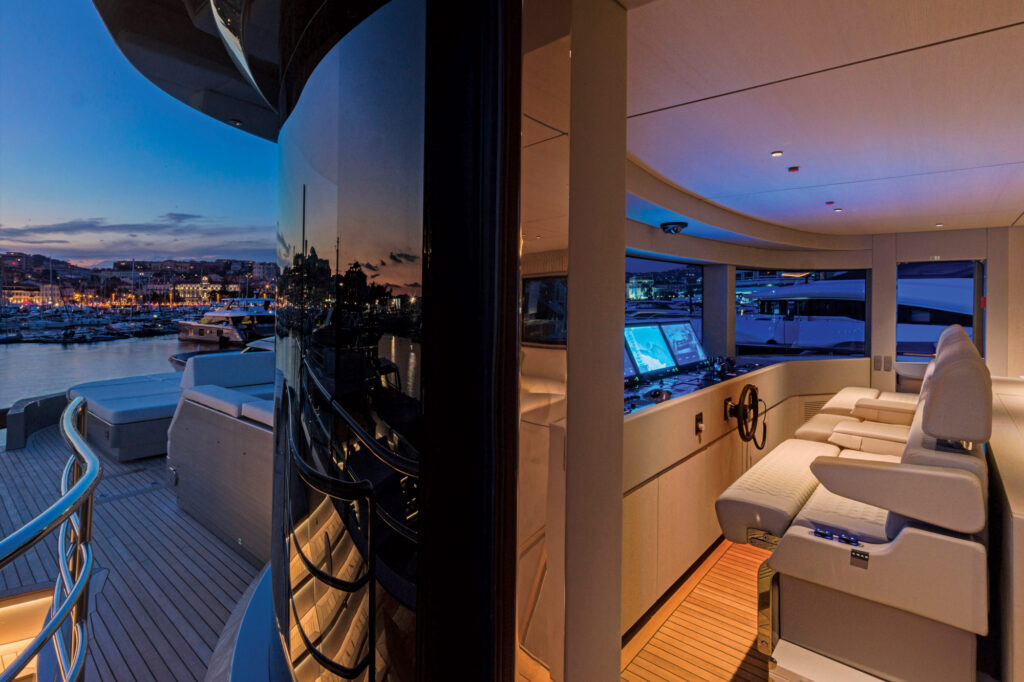
More speed is possible with bigger engines. The third Maiora 35 Exuma has triple 2,600 hp Caterpillar diesels and a reported top speed of 42 knots. As for range, Pesa II should manage around 1,250 nautical miles at 10 knots.
Water-jet-propelled vessels have their advantages. They not only allow for a relatively small engine room aft, but they also are highly maneuverable. They have far less vibration and are ideally suited to shoal-water cruising, with no protruding props or shafts. The maximum draft on Pesa II is just 4 feet, 7 inches, and that’s at a full-load displacement of 375,000 pounds. Yachts with water jets can also deliver a crash stop, which normally means hauling up within not much more than a boat length from any speed.
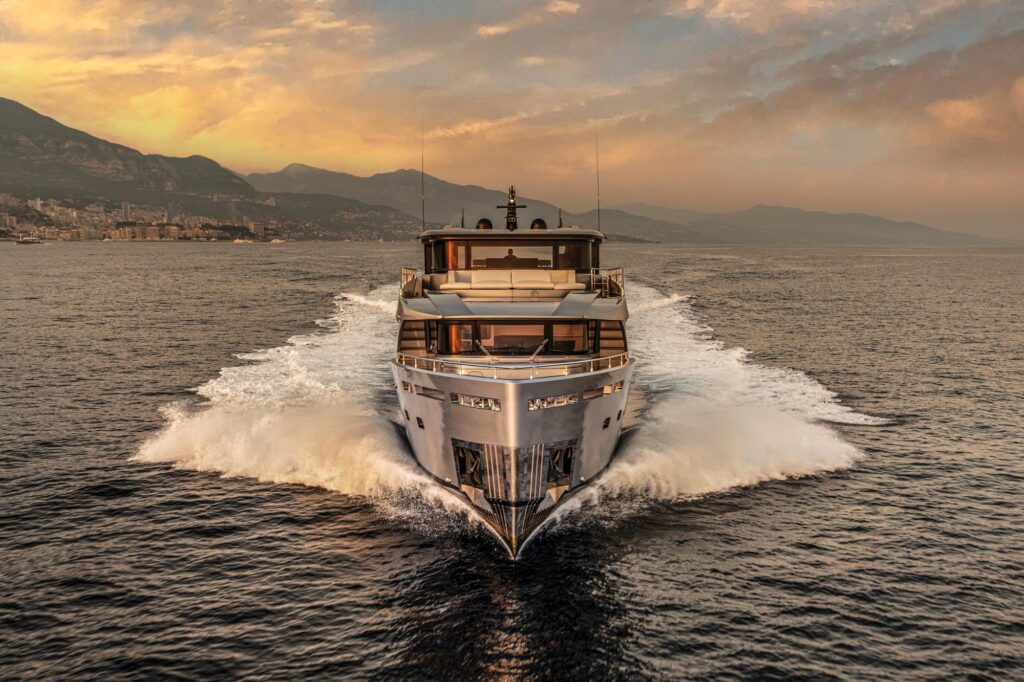
For tenders, there are two garages aboard the Maiora 35 Exuma. One is aft beneath the cockpit for an 11-foot-6-inch service tender or two PWC, while the other is a “dry” transverse space for a 21-foot main tender. That’s a good-size ride to head out in for some exploring, but with so much to enjoy on board the Maiora 35 Exuma, most owners and guests won’t be gone for too long.
The First Exuma
The first Maiora 35 Exuma, Lady Nina, was delivered in 2020 to Central American owners. It is now based in Fort Lauderdale, Florida, and was exhibited at the most recent Fort Lauderdale International Boat Show. It has a darker, contemporary interior, and triple 1,925 hp Cats for a top speed of 35 knots.
Jet Experts
The Next Yacht Group has more experience with water-jet installations than most other yacht builders in the Maiora 35 Exuma’s size segment. This group has been delivering such craft consistently for well over 30 years.
What’s in a Name?
The Maiora name comes from the Latin phrase ad maiora, which roughly translates as “toward greater things.” A new range of Exumas is being worked up by architect Marco Casamonti, whose first project with the Next Yacht Group is the AB110 expected to debut later this year.
Made in Italy
Formerly known as FIPA Italiana Yachts, the Next Yacht Group is headquartered in Viareggio, a resort city on Italy’s west coast that is home to many of the nation’s best-known yacht builders. The group includes the Maiora, AB and CBI Navi brands. Maioras are built in Viareggio, while Maiora Exumas and ABs are built in nearby Massa. The CBI Navi brand is reserved for custom metal vessels.
Take the next step: maiora.it









